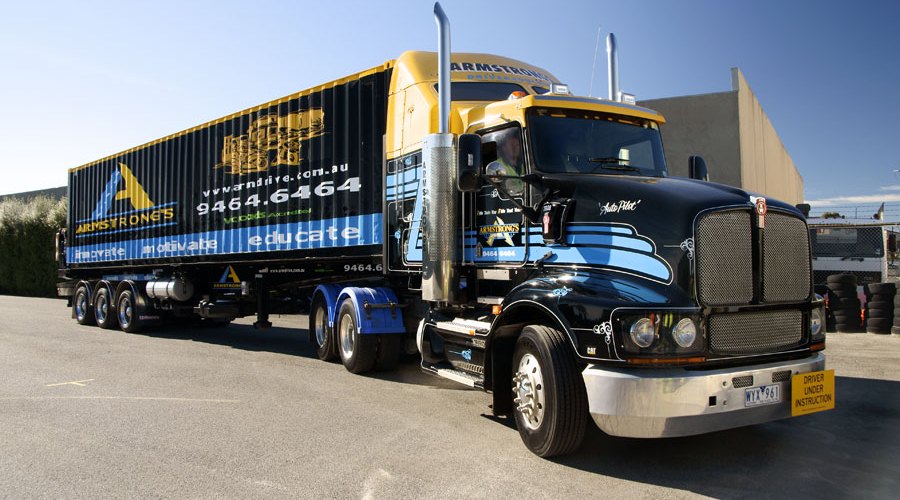The New Year is upon us. All the best to everyone out there and we wish all our clients happy and safe driving.
But what did we learn from 2015 that we can take into 2016 regarding heavy vehicle training and assessment? Not much. Nothing to be precise. The heavy vehicle licensing regime in its current format continues to ‘churn & burn’ whole geographic areas of Melbourne and beyond. Some areas of Melbourne have effectively been “licensed out”. No more available customers. It appears that every man and his dog has a licence to drive a heavy vehicle.
While the heavy vehicle training industry may not have learnt a thing from 2015 (or 2014, 2013, 2012…), Armstrongs will continue to be vocal about the flaws in the current heavy vehicle licensing regime in the hope of effecting change. Why? Because we are tired of hearing from our industry contacts that new entrant drivers can’t drive a greasy pole up a monkey’s…ahem…you get the picture. Also because we are fed-up with being tarred by the transport industry with the same brush as some of our competitors. We couldn’t be more insulted!
So how do we get better drivers if the “system” is so flawed? Easy! Because the power to effect change and produce better drivers at the licensing level is actually with the transport industry and NOT with the regulator. Always has been, always will be. The regulatory authority obviously has the power to change the heavy vehicle licensing system, but industry has the power to make changes immediately!
Ultimately though it’s the Operations Managers, HR Managers and Training Managers of freight transport and public transport companies that set the quality and quantity of the amount of training that any new prospective applicant driver will need to undertake in order to land a driving role with them.
Therefore, as is the case now, if the industry makes zero demands on new applicant drivers to evidence a minimum of ‘X’ hours of training, having achieved a competency level of ‘X’ percent, across ‘X’ number of driving skills, then industry will continue to get new applicant drivers with zero talent. That’s not brain surgery – that’s not even rocket science.
But isn’t the fact that a new applicant driver has a licence enough? Absolutely not! The threshold for obtaining your heavy vehicle license under the current regime is so low, and it covers mainly low level and intermediary driving skills, that there is a snowflake’s chance in hell that it can deliver what the industry needs and wants.
The point is, Operations Managers, HR Managers and Training Managers need to treat a new entrant driver’s heavy vehicle licence as a mere legal requirement – which is categorically no indication or warranty that the said licence holder knows anything about driving one of your rigs with your clients freight onboard. At this point, Ops Managers and the like need to ask new applicant drivers “so tell me about your driver training. Where did you do it? What did it involve? How long was your course? How many hours behind-the-wheel training did you receive?” The list goes on.
See, the problem is not that transport companies and like don’t want to give newly licenced drivers a go, it’s that they have no faith in the current licensing system because there are no minimum training timeframes in place which means accredited providers are allowed to put their own capital interests before road safety and industry’s needs. This results in new entrant drivers struggling to secure a driving role because they haven’t spent enough time behind the wheel, and industry struggling to fill their driving positions because most applicants can’t get past the internal driver evaluation. This pickle of a situation resulted in someone, somewhere, plucking from thin air the “minimum 2 years driving experience” rule. There’s no logic to it (ie does 2 years of ‘bad’ driving experience count?) but in lieu of a robust licensing regime the industry had no choice but to try and protect itself from just plain old terrible accident prone drivers somehow.
However it’s not all doom and gloom out there. We are encouraged to see that there are a select few freight transport and public transport companies out there who have contacted us to talk about how they can obtain better driving resources in 2016.
So, to all the Operations Managers, HR Managers and Training Managers of road freight and public transport companies, if you want better drivers start making minimum training demands on your new entrant drivers. To all the new entrant drivers out there, if you want a driving job, start placing minimum’ behind-the-wheel’ training demands on yourself.
C’mon industry! Help us help you. Forget about “licensing” and start imposing your own needs and wants on the heavy vehicle training industry via new entrant drivers. You never know, you may actually end up getting what you need and want!
If you’re a proactive road freight or public transport organisation and you want to improve the standard of applicants applying for driving roles with your organisation, give Armstrongs a call and we will be happy to discuss your needs and put together a ‘training pathway’ for new entrant drivers into your organisation. What do you have to lose? Better drivers…



